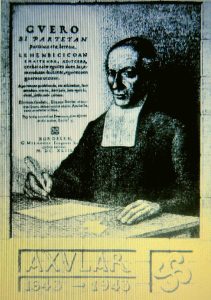There are some people that become larger than life, who take on new roles in the popular imagination because of their accomplishment and become legendary characters in their own right. Axular is one such person. A priest who served many years in the Lapurdi town of Sara, he became mythic, the protagonist of local legends. Most of the time, we lose the connection between the myth and reality, but in this case, we know a bit more…

- Pedro de Aguerre y Azpilicueta was born in 1556 in Urdax (Nafarroa) in the house for which he was known, Axular. Little is known about his early life. He likely attended school at the local monastery of San Salvador, founded in the ninth century. He later studied at the University of Salamanca. We don’t know what he studied but we know his knowledge was extensive, based on his writings.
- He was ordained a subdeacon in Pamplona/Iruña in 1584 when he was 28 years old. After several years bouncing between different posts, he became the parish priest of the village of Sara in Lapurdi in 1600. Another priest disputed his appointment, arguing he deserved it more and that Axular was a foreigner but eventually, with the favor of Henry IV, King of France and Nafarroa, Axular was able to maintain the position.
- He remained in Sara until his death in 1644 at the age of 88. He created an environment in which religious debate flourished and he was also involved in efforts to use the Basque language to reconvert Christians.
- Perhaps his single greatest achievement is his work Gero (Later). Printed in Bordeaux the year before he died, Gero is considered one of the greatest literary works in Basque. Written in the dialect of Lapurdi, it is known throughout the Basque Country. The work, comprised of sixty chapters, advocates an ascetic lifestyle – abstaining from sensual pleasure – and emphasizes the harm in delaying one’s religious duties and obligations. Its title is inspired by the Basque proverb Gero dioenak bego dio – Whoever says later, says leave it. Thus, Axular is really emphasizing the dangers in procrastination and being lazy in one’s duties.
- Beyond its religious theme, Gero has been analyzed for its prose and reasoned arguments. He wrote Gero as if it were a sermon to his parishioners. Because of its impact, some consider Axular the Shakespeare of Euskara: a model of language that others should hold as a standard. Some elements that others have praised include his use of popular sayings to get the attention of the reader and his use of language to lighten what is a rather heavy topic.
- Axular’s fame was such that he became part of the local stories, taking the place of other mythological figures. He thus became the protagonist in stories involving the devil Etsai, who though an erudite teacher also held some of his students in servitude.
Primary sources: Estornés Lasa, Bernardo. Axular, Pedro (1556-1644). Auñamendi Encyclopedia. Available at: https://aunamendi.eusko-ikaskuntza.eus/en/axular-pedro-1556-1644/ar-6754/; Gero, Wikipedia; Axular, Wikipedia


